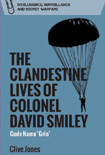|
The Clandestine Lives of Colonel David Smiley: Code Name ‘Grin’
by Clive Jones
|
 This is a book about a remarkable and gallant officer; it is also a book about Hybrid Warfare, long before General Gerasimov made the concept famous. Finally, it is a book about the varied failings of the military system, in particular its inability in peacetime properly to employ and retain (p.282) the type of officers whom it needs in war – an issue with which it seems still to struggle. This is a book about a remarkable and gallant officer; it is also a book about Hybrid Warfare, long before General Gerasimov made the concept famous. Finally, it is a book about the varied failings of the military system, in particular its inability in peacetime properly to employ and retain (p.282) the type of officers whom it needs in war – an issue with which it seems still to struggle.
Clive Jones is Professor of Regional Security at Durham University’s School of Government and International Affairs, and this compliments one of his previous works, Britain and the Yemen Civil War 1962-1965. That delved deeply into the activities of the British Mercenary Organisation over three years; this covers Smiley’s life in its entirety over several campaigns. It is interesting from a military history point of view, from a Middle East regional perspective – and as a forerunner of the type of conflict which British Forces have experienced ‘anew’ over the past two decades.
The work is structured chronologically around discrete phases of Smiley’s life: regimental duty, pre-War and on operations in Abyssinia, Palestine, Iraq and Iran, service with the Commandos, then with the Special Operations Executive in Albania and Siam; his post-military service in the Mediterranean, Oman, and in Yemen, and finally a valedictory chapter.
Many of the situations in which Smiley found himself and the comments that he recorded would not be out of place today, such as when working with local forces. For example: ‘Many BLOs came to spend as much time trying to reconcile competing ideological and political agendas between various partisan and guerrilla groups as they did fighting the Germans and Italians’. Similarly, Smiley experienced the competing political agendas of allies, also seen in recent conflicts: ‘Under the umbrella of SEAC, the activities and policies of the OSS and Force 136 should have been coordinated. In reality, both services ran separate operations into Siam with little joint planning’
In parallel to the repeating situations, many of the locations in which Smiley soldiered, Raqqa, Habaniyya, Baghdad, Hebron, Iran, Yemen, Benghazi, southern Siam etc, are again scenes of conflict: geo-strategic issues, ethnic complications and complex terrain remain mostly the same, no matter the flag that flies over them. Often the recurrent locations are replete with recurrent notable families as allies or enemies, and sometimes both, as with the Palmach terrorists’ looting of a British armoury ‘under the instruction of a Jewish intelligence officer responsible for field security around the base’.
Throughout, there are interesting details about the various campaigns, which – as well as echoing the current conflicts – illuminate hitherto unexplained aspects, such as the way the deception plan for the assault on J Akhdhar was disseminated; or the price for Israeli logistical support to the Royalists in Yemen being political recognition of Israel (as well as tying down and degrading Nasser’s army in Yemen: ‘At the time of [the 6 Day War] Egypt still had over 50,000 troops in Yemen’.
While Jones is an academic, this is not solely an academic’s book; it is written in fluid English and annotated adequately but not excessively. Jones draws upon primary and secondary documentary sources, as well as interviews with many of those involved, including with Smiley himself.
Inevitably, there are a couple of minor mistakes: the Euphrates can be crossed but not forded just above Baghdad; the cap comforter becomes a camp comforter (p.104); most Sana’anis are Zaydi, not Shafa’i. There are also the usual issues of transliteration from Arabic such as Kameshle for Qamishli, Shaffei for Shafa’i etc; Jones also uses GI and GII for G1 and G2. These are rarely such as to cause confusion.
As too often, a major issue is with the quality of the mapping, and in particular the lack of terrain. In Albania, Oman and Yemen, the immensely complex terrain (‘the brutally rugged mountain terrain where the fighting was taking place’) greatly favours asymmetric forces. Yet from the book’s sketch maps, one would have thought that the terrain closely resembled Norfolk’s. The other major issue is the extortionate price: at £80 in hardback, the book is clearly aimed at university libraries with lavish budgets (and still lacks decent mapping despite that iniquitous price.) The paperback is a more reasonable £24.99.
This is a readable and engaging book about a swashbuckling Household Division officer (and war correspondent for this magazine), who never received in life the full recognition from his country that he deserved. This book goes a considerable way to righting that wrong, as well as being an interesting window on relevant, if forgotten, campaigns. Highly recommended.
James Spencer
edinburghuniversitypress.com
|
|